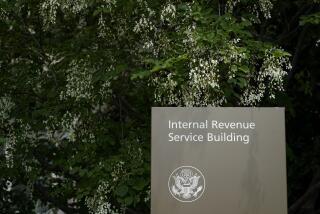$300 Billion in Taxes Not Paid, Study Finds
- Share via
The difference between what taxpayers owe the government and what they actually pay on time totals more than $300 billion a year, the Internal Revenue Service said Tuesday.
A research project at the tax agency found that the tax gap ranged from $312 billion to $353 billion in tax year 2001, compared with an earlier estimate of $311 billion. The project assessed individual, not corporate, taxes.
IRS enforcement activities helped recover about $55 billion of that total gap, leaving a net tax gap of $257 billion to $298 billion, the IRS said.
That yields a noncompliance rate of 15% to 16.6%, according to the IRS.
“Even after IRS enforcement efforts and late payments, the government is being shortchanged by over a quarter-trillion dollars by those who pay less than their fair share,” said Mark Everson, IRS commissioner. “People who aren’t paying their taxes shift the burden to the rest of us.”
The tax gap findings come from a three-year National Research Program study, which audited 46,000 individual income tax returns for 2001. The preliminary results yielded a tax gap range that will then be refined into a final estimate by the end of this year.
The tax gap includes three components: underreporting income, underpayment of taxes and failure to file tax returns.
The study found a modest deterioration in tax compliance among individual taxpayers since the last study in 1988.
Individual income tax was the single largest source of the tax gap, accounting for two-thirds of the total, the IRS said.
The main culprit, underreporting of income, accounted for more than 80% of the total tax gap. Non-filing and underpayment each accounted for about 10% of the gap, the IRS said.
Underreporting was mostly linked to understated income, not overstated deductions, while most of the understated income was related to business activities, not wages or investment income, according to the IRS.
The IRS said it would use the data to update the tools it uses to select returns for auditing.
More to Read
Inside the business of entertainment
The Wide Shot brings you news, analysis and insights on everything from streaming wars to production — and what it all means for the future.
You may occasionally receive promotional content from the Los Angeles Times.










